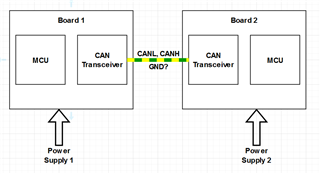Tool/software:
Hello Team,
We are using the CAN transceiver TCAN1051HGVDR in one of our projects.
The block diagram is as shown below.
We have CAN between board 1 and board 2.
Both the boards are powered from different power supply.
1). Do we need GND signal running between Board 1 and Board 2.
Since CAN is differential signalling, the CAN H will be referring to CAN L.
Please correct me if I am wrong.
2). So can I use a simple 2 wire twisted pair cable for CAN H and CAN L lines?.
3). Do we need GND also running from Board 1 to Board 2 as a common reference?.
Looking for your reply.

